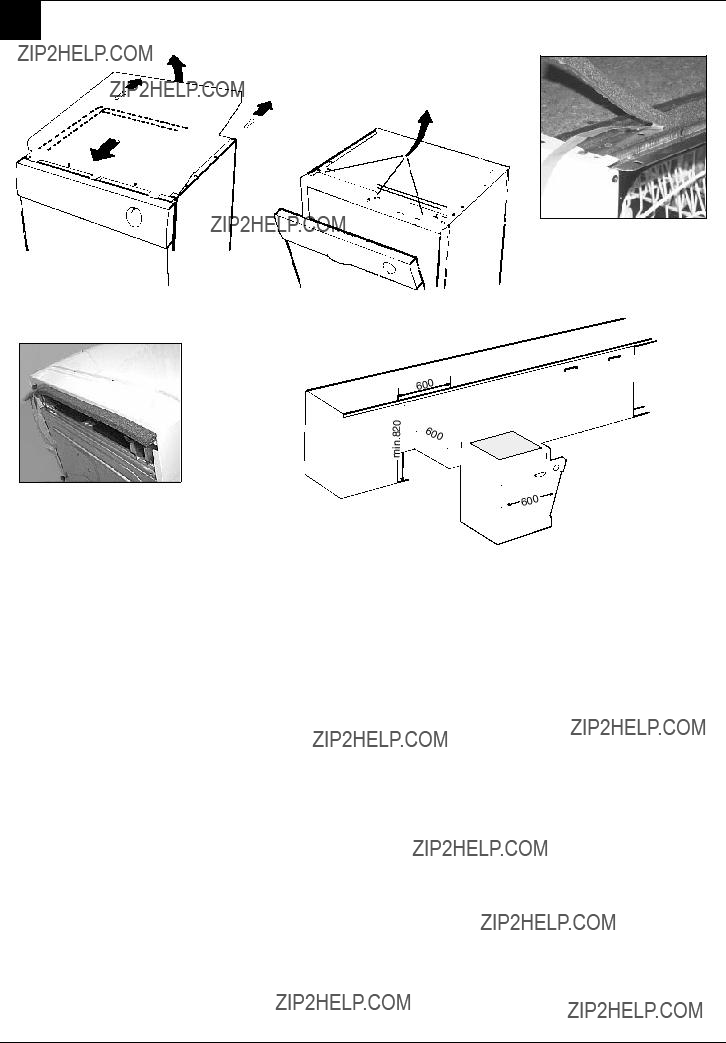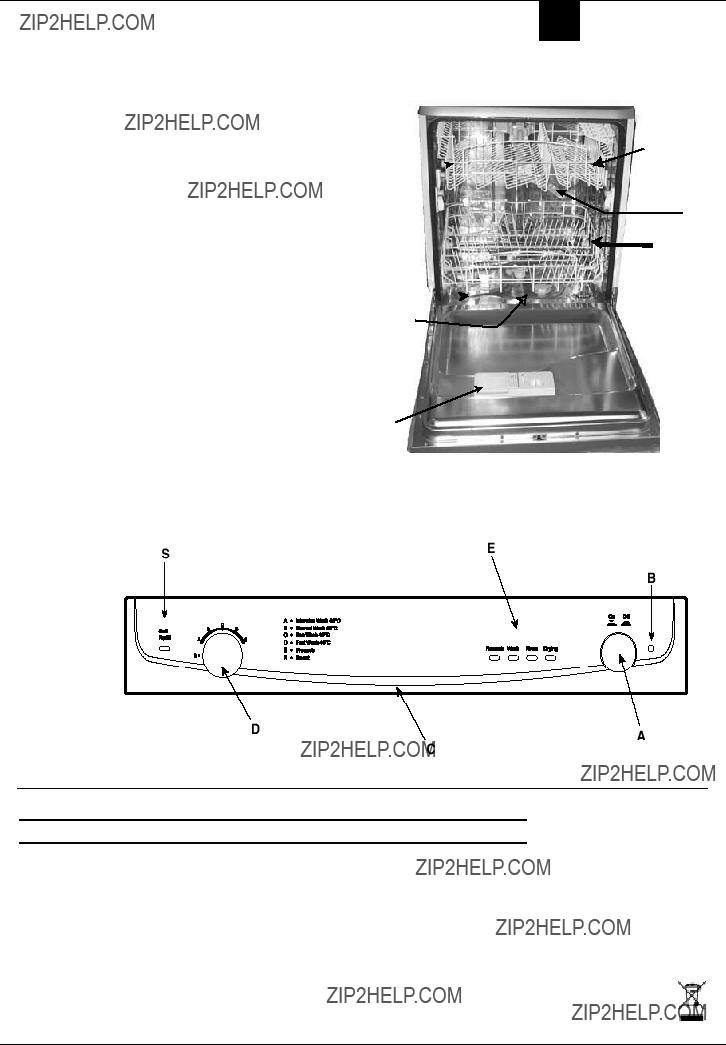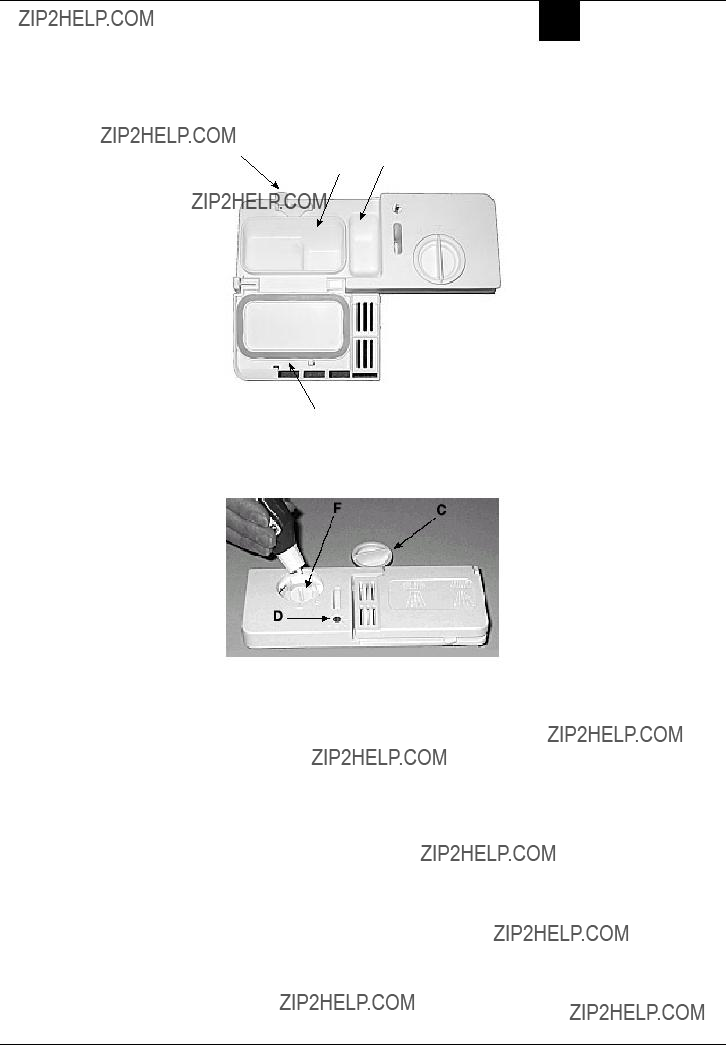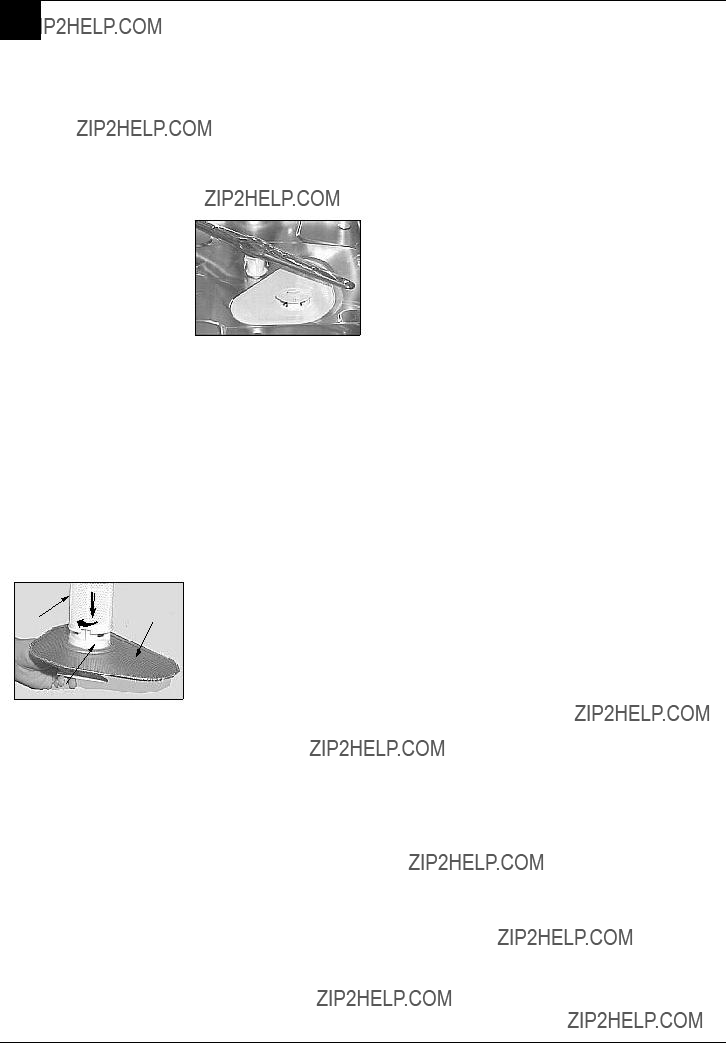
Instructions for Installation and Use
Aquarius FDW20 60cm free standing
Dishwasher

Instructions for Installation and Use
Aquarius FDW20 60cm free standing
Dishwasher

D ISHWASHER
Contents
Retention of this Instruction Book
This Instruction Book must be kept handy for reference as it contains important details on the safe and proper use of the appliance.
If you sell or pass the appliance to someone else, or move house and leave it behind, make sure this Book is also provided so the new owner can become familiar with the appliance and safety warnings.
If the Book is lost or damaged a copy may be obtained from:
Indesit Company UK Ltd. Morley Way, Peterborough, PE2 9JB.
2

Electrical Connection
WARNING: This appliance must be earthed.
Fuses
Your appliance comes fitted with a plug and a 13A fuse. If you need to replace the fuse, only those rated at 13A and ASTA approved to BS1362 should be used. If you lose the fuse cover, a replacement may be obtained from your local authorised Service Centre or Electrical company. Correct replacement is identified by colour coding or the marking on base of plug.
WARNING: DO NOT use the plug unless the fuse cover is fitted.
Changing the Plug
Cut off and dispose of the supplied plug if it does not fit your socket.
WARNING: To avoid a shock hazard DO NOT insert the discarded plug into a socket anywhere else.
IMPORTANT: WIRES IN THE MAINS LEAD ARE COLOURED IN
ACCORDANCEWITH THE FOLLOWING CODE:
If you change the plug, the colour of the wires in the mains lead may not correspond with the terminal markings in the plug, which if not coloured, could be:
Changing the Mains Lead
A lead can be ordered from Hotpoint Service UK: 08709 066 066 or
Republic of Ireland: 1850 302 220
If you have damaged the existing lead or require a longer one a charge will be made. It is strongly advised that this work is carried out by a qualified electrician.
If the domestic wiring includes a residual
D ISHWASHER
Safety Information
At the time of delivery...
All functions of your dishwasher have been thoroughly tested at the factory. A small number of water marks may have been left as a result, they will disappear when the appliance is used for the first time.
WARNING: The dishwasher must not be connected to the electricity supply while installation is being carried out.
-This appliance should only be connected to a 230/240V AC source, via a properly installed earthed socket.
-Use the dishwasher solely in a domestic environment.
-DO NOT stand or place heavy objects on the door when it is open, this could damage the door or cause the appliance to tip forward.
If your family includes children...
-DO NOT allow children to play with the appliance or tamper with its controls.
-Keep detergents and rinse aids away from children. Keep children away from the open door of a dishwasher, there could still be some detergent left inside.
CAUTION:
The dishwasher meets the requirements set out by the regulations in force concerning safety and electrical equipment.
Any technical checks should be conducted exclusively by a trained and authorised technician: Repairs carried out by unaithorised persons will invalidate the guarantee, as well as posing a potential hazard to the user.
The manufacturer declines all responsibility for damage to persons or property resulting from failure to observe the above precautions, from tampering with even a single component or from the use of non- original spare parts.
3

D ISHWASHER
For your Safety
This manual forms an integral part of the appliance. It must always be kept handy for reference. Read through all the instructions contained in this manual before using the dishwasher.
Installation must be performed by a qualified technician, in compliance with the regulations in force, including the prevention and elimination of radio frequency interference.
The dishwasher is designed for washing and drying dishes, any other use shall be considered improper. The manufacturer declines all responsibility for uses other than those described above.
1.Seperate the various packaging materials and dispose of safely - DO NOT leave discarded packaging materialaroundthehome.
2.Afterremovingthepackaging, check to make sure your appliance is intact. If in doubt, contact a qualified professional.
3.DONOTuse extensionleads and multiple plugs. If the electricity supply wire is not long enough, then have it replacedwithoneofthecorrect length and remember that it should be free of bends or dangerouskinks.
4.In the event of any damage to the power cord have it replaced by a qualified technician.
5.The mains plug must be easily accessible after installation.
6.If the appliance is not operating properly or if maintenanceoperationsare necessary, disconnect the dishwasher from the mains power supply (unplug it!).
7.DO NOT install outdoors, not even if the area is covered by a roof: it is extremely dangeroustoleaveitexposed torainandthunderstorms.
8.If installed on a carpeted or covered floor, ensure that the openingsontheundersideare not obstructed.
9.Do not touch the heating elementduringorstraightafter a wash cycle.
10.Iftheappliancemalfunctions, turn off the water inlet tap and disconnecttheplugfromthe wall socket. Then read the sectionentitled "Troubleshooting".Ifyou cannotresolvetheproblem, thencallHotpointService (seeKEYCONTACTS,back page).
11.Cutlery and sharp utensils shouldalwaysbeinsertedin randomorder,withtheblades pointingdownwards(take care with knife blades).
12.For your own safety ensure the door is closed when the dishwasher is in use.
The rating plate, featuring the technicaldata,serialnumber andmarkings,isvisibly positionedontheinneredgeof thedoor.
DONOTremovetheratingplate.
The dishwasher is intended for use by adults. DO NOT allow children to come near or play with the controls.
Keep children away from detergents and clear of the dishwasher door whenopen.
Keep all packaging material away from children.
1.DO NOT use solvents, such as alcohol or turpentine which may cause an explosion.
2.DO NOT load dishes to wash that are soiled with ash, wax or paints.
3.DO NOT lean, sit or stand on any part of the dishwasher - this could causeinjuryand/ordamagetheappliance.
4.DO NOT drink any water residues from inside the dishwasher.
4

D ISHWASHER
Installation
Choose where you want to install your dishwasher, you can place it so that its sides or back panel are side by side with furniture or up againstthewall.Thedishwasheris providedwithwatersupplyanddrain hoses, which can be directed towards the left or right to facilitate appropriateinstallation.
Levelling.
Once the appliance is positioned, adjust the feet by screwing them in or out depending on how high you want it and to level it so that it is horizontal. Make sure that it is not inclinedmorethan2degrees.Ifthe applianceislevel,itwill helpensure itscorrect operation.
Height Adjustment
Insert the appliance into the cutout andthenadjusttheheightusingthe screws located on the front bottom
Connect to the Water Supply...
-For your dishwasher to operate correctly it requires water
-Ensurethatthenewhosesupplied is connected and the old hose is disposed of safely.
-Ensure the fill hose is only fitted to the cold water supply. DO NOT overtighten the hose connector, hand tight is sufficient.
-Ensure the fill hose is not kinked.
-Tap connections (if applicable): A range of adaptors are available to suit your tap.
-DONOTconnectthedishwasher to a single outlet instantaneous water heater or an electric heater.
Drain hose connection.
WARNING: Connect your dishwasher drain hose to pipes which connect to the foul drain system and not to surface water drains.
IMPORTANT: For the correct operation of your dishwasher, it is essentialtocomplywiththefollowing information:-
Standpipe:
Ensurethatthehoseisnotpushed toofardownthestandpipe.
Iftheendofyourdrainhoseisfitted with???retainingflaps???,ensuretheyare insertedfullyintothestandpipe. This will prevent the pipe from jumping outduringinstallationanduse.
SinkWasteSystem:
Forundersinkdrainage:
Before connecting the drain hose, remove any internal restrictions - Thiswillpreventabuildupofdebris whichcouldcauseablockage.
Remove any restrictions from the waste spigot and ensure that the sealingbungisremoved.Thehose should be routed, such that it is raised to a minimum height of 800mm(31/2???).
NOTE: Ensure the sink outlet pipe has a minimum diamtere of 32mm.
part of the machine. Use a screwdriver to turn the screws in the clockwise or
Yourdishwasherisprovidedwith aspecialsystemwhichblocksthe watersupplyintheeventofleaks insidetheappliance.
Cold water connection.
Connect the cold water supply hose, If the water hoses are new or have been out of use for an extended period of time, let the water run to make sure it is clear and free of impurities before making the connection. If this precaution is not taken, the water inlet could get blocked, causing damage to your dishwasher.
DO NOT position the standpipe near an electrical outlet. ENSUREthatthedrainhoseisnot kinked and it is routed as shown in thediagram.
The standpipe should have a bore of at least 38mm (11/2???). It should be installed as shown, have a trap fitted and must discharge into the same drain system as your householdsink.
It MUST NOT be connected to a surface water drain.
1.Untie the end of the GREY drainage hose from the rear of the appliance.
2.Reposition the ???Hooked End Support??? as required along the GREY drainage hose.
3.If fitting an under sink waste disposal unit, cut out the membrane, bung or blanking plug.
Ensure the drain hose is securely attached, to prevent it coming away while the machine is in use and causing a flood.
5

D ISHWASHER
3
1
2
4
5
INSTRUCTIONS FOR INSTALLING THE DISHWASHER IN
Your freestandingdishwasher canbeinstalledinmodernkitchensasfollows:
lto stand next to furniture units or other electric household appliances
(Pleasereadthechapteron ???Installation???intheinstructionmanual.)
lto insert or
Shoulditbenecessarytoremovethetopshelfofthedishwasher,proceedasfollows:
???Unscrewthe2rearscrewsandthen,withalightpushforward,letitslideoutandremoveit(seefig.1)
???Discardthepolystyrenerectangle.
???Openthedoorand,afterunscrewingthefixingscrews,removethe3plasticplugsusedtohooktheshelfon(fig.2)
???Glueonthesmallsoundproofingadhesivespongystripontothetopcrosspiece(photo3)and,aftertiltingtheappliance,glue onanotheroneunderneaththebase(photo4).
???
???Inserttheapplianceunderneaththeworktop(fig.5),checkingthattheinletandoutletpipesdonotgetbentorsquashed (please readtheinstructionsprovidedinthe???Installation???chapter).
Warning:
Thedishwasherplugmustbewithinaccessoncetheappliancehasbeenbuiltin,inordertoallowformaintenancetobecarried outsafely.
Thestructureofyourdishwashermakesitimpossibletofititunderahob.
6

Getting to know your Dishwasher
D ISHWASHER
E
The Controls
G 
J
I
F
H
 K
K
A.
Press this button to switch the applianceon.
B.
This light informs you that the dishwasher is on.
C.Door opening handle
Usethishandletoopenthedoor.
D.Knob for selecting cycles
Usethisknobtoselectthecycle.
E.Cycle phase indicator light
Thes indicator lights inform you which cycle phase is underway (prewash,wash,rinses,drying).
S.Low Salt indicator light
This light warns you that it is time to add more salt.
L
7HFKQLFDO???FKDUDFWHULVWLFV
Thisdishwasherconformstothe followingEuropeanCommunity Directives:
???73/23/EECof19/02/73(Low Voltage)andsubsequent modifications;
???89/336/EECof03/05/89 (Electromagnetic Compatibility)andsubsequent modifications;
???97/17/CE
(Labelling)
???02/96/CE (Waste Electrical and Electronic Equipment)
7

D ISHWASHER
How to use your Dishwasher
First of all.
-Turn on the water supply tap completely.
-Add the correct amount of detergent.
-Load the baskets correctly.
-Check that the spray arms rotate freely.
-Close the door securely.
-Press the
Select the wash cycle.
Select the wash cycle by turning knob "D"clockwiseuntiltheindica- torisinlinewiththeletterofthewash cycle required.
Selectthewashcyclemostsuitable for the type of dishes to wash (see ???Programme Chart???).
After a few seconds the indicator light ???G??? will come on, indicating the wash cycle has begun. It is not advisable to make any changes at this point.
Indicatorlights.
Yourdishwasherhasindicatorlights "G" which light up to indicate the washcyclephasethatisunderway.
Modifying a wash cycle in progress.
Ifyouhavechosenthewrongcycle - You can modify the wash cycle in progress, if it has only just started. Turn the knob
You've left out a dish?
Interrupt the wash cycle by press- ing the
When you shut the door, press the
Cycle end
The end of the wash cycle is indicated by the flashing of the drying phase indicator light.
Warning!
Turn the appliance off by pressingbutton???A???,unplugthe appliance from the electricity socket to cut off the power supply;thepowersupplycable should consequently be easily accessible.
Turn off the water tap.
Wait a few minutes before unload- ing the dishes: they are very hot! If youwaitalittlewhile,theydrybetter due to the steam.
Empty the lower basket first.
There's been a power failure or you opened the dishwasher door
The wash cycle stops and then restartswhentheelectricitycomes backonorwhenyouclosethedoor.
For your own safety, ensure the door is closed, when the dishwasher is not in use.
8

Programme Chart
Select the most suitable programme for the type of dishes and how dirty they are. To select the wash programme see the chart below:
D ISHWASHER
Select the right wash cycle for your dishes. Selecting the most suitable wash cycle for the load ensures clean dishes and a more economical use of water and electricity.
To optimise wash performance and save on energy, try to use the dishwasher with a full wash load. If it takes some time to fill your dishwasher, use the
9

D ISHWASHER
1.Unscrew the salt container cap
2.There is an arrow on the neck
Salt
Filling the salt container.
Always use salt which is intended for dishwasher use.
The salt container is situated underneath the lower basket, fill it upasfollows:
1.Pull out the lower basket completely, unscrew and removethecontainercap
2.If it is the first time you add the salt,firstfillthecontainerupwith water (you won't have to do this againnexttime)
3.Putthedishwasherfunnelonthe hole and pour in approximately two kilos of salt. It is normal that some water comes out of the container.
4.Screw the cap back in place carefully.
When to add salt:
The salt container should be filled up when the low salt indicator light ???S??? flashes.
The dishwasher will remind you to do so for five consecutive wash cycles.
WARNING:
DO NOT pour detergent into the special salt container - This will de- stroy the water softener.
10

Before Using your Dishwasher
D ISHWASHER
???Use the right amount of detergent (seeprogrammechart).
???Store your detergent and rinse aid inacool,dryplace,safelyawayfrom children.
Rinse aid.
Rinse aid makes dishes sparkle moreasitimprovestheirdrying.The rinseaidcontainerissituatedonthe insideofthedoor.
Youshouldfilltherinseaidcontainer when indicator D lights up to show you it is empty.
Adding rinse aid.
To open the dispenser, turn capC anticlockwise.Takecarewhenyou pour in the rinse aid to avoid it overflowing. You can regulate the amount of rinse aid used by the dishwasher, move the adjuster F whichyouwillfindunderlid C.
- The amount of rinse aid needs to be increased if the dishes appear dull or you can see circular stains.
- The amount of rinse aid needs to be reduced if the dishes are sticky or you can see white streaks.
You can choose from six different positions. It is normally set to 4.
Warning
If the water in your area is hard or very hard, we still recommend you pour extra salt into the relevant dispenser to prevent the formation of white streaks on your dishes or on the interior of the appliance.
Using a
If you want to achieve perfectly dry dishes, you may add rinse aid as long as the dosage adjuster is set to no.2. In any case, please read the manufacturer's instructions on the packet.
If you use only these products, it is normal for the salt and rinse aid indicator lights to flash permanently after a certain number of cycles.
11

D ISHWASHER
Loading your Dishwasher
First of all.
Beforeplacingdishesinthebaskets, removeallcoursefoodremains.This avoids blocking the filter, which would reduce the efficiency of the wash.
If saucepans and frying pans are verydirty,allowthemtosoakbefore beingwashed.
Tomakeiteasiertoloadyourdishes, pull the baskets out.
What goes into the lower basket?
Werecommendyouplacethemost difficultdishestowashintothelower basket: saucepans, lids, soup dishes and plates (a load example isshowninthephoto).
???Servingdishesandlargelids: place them on the sides of the basket.
???Saucepans,saladbowls: must alwaysbeplacedupsidedown
???Very deep dishes: placethem obliquely,thusallowingwaterto run down them and cleaning thembetter
???Glasses and cups: position themasshowninloadexample photo.
Thecutlerybasketisequippedwith two removable grids. Cutlery and sharp utensils should always be inserted in random order with the blades pointing downwards (take care with knife blades.
Position them so that they don???t touch.
Afterloadingthedishes,remember to check that the spray arms can turn freely without hitting against any dishes.
How to adjust the upper basket.
Theupperbasketcanbesetinhigh or low position to enable you to organise your dishes effortlessly.
Opentherailstopflapsandpullthe rackoutcompletely.Nowplaceitin thehighorlowposition,thenslideis along the guide rails until the front wheelsalsogoin.
Now close the rail stop flaps. Follow the sequence 1,2,3,4 illustrated (Fig. F).
What can I Wash Items not suitable for the dishwasher:
???
???Avoidwashinghornhandledandbronzecutleryinthemachine.
???Delicate/decorative glassware and vases, special antique or irreplaceable china - the decorative patterns printedontheseitemswillnotbedishwasherproof.
???Plastic objects that are not resistant to hot water.
???Copper and Pewter utensils. Aluminium and Silver objects.
???Some types of glass can become opaque in appearance after they have been washed too many times in a dishwasher.
???Highly absorbent materials such as sponges and towelsshould never be placed in a dishwasher.
???If in any doubt, check with the manufacturer on items suitability for dishwasher???s.
WARNING: Dishes or cutlery soiled with tobacco ash, wax, lubricating grease or paint should not be put
in the dishwasher.
12

INFORMATION FOR TEST LABS D ISHWASHER
Load for 12 Standard Settings
&
???
tests (upper rack at top position)
upper basket
Loading the detergent
The cleaning detergent should be introduced into the two containers ???Comp.2??? and ???Comp.3??? (see table at the end of the page).
Loading the Rinse Aid
The amount of rinse aid used for each cycle can be regulated by turning the dose adjuster ???F??? which you will find under lid ???C???.There are 6 different settings; the normal dosage is setting 5.
D
Comp.2Comp.3
F
Thisbasketisequipped with two removable grids: insert the cutlery one by one into the slots, with the handles at the bottom. Position them so that they don't touch.
C
door side
*Press the ???extra dry??? button, if existing.
13

D ISHWASHER
Care and Cleaning
Unplug the appliance.
Before carrying out any cleaning ormaintenanceonthedishwasher, always remove the plug from the electricitysocket.
After every wash.
Whenthewashcyclehasended, always remember to turn off the water supply tap and to leave the appliance door ajar. This way, moistureandbadodourswillnotbe trappedinside.
The filter assembly
???Ifyouwantconsistentgoodresults fromyourdishwasher,youneedto cleanthefilterassembly.
???Removethelargerfoodparticles trappedinsidethecup???C???andthe
???Theentirefilterassemblyshould becleanedthoroughlyonceamonth: cup C +
For cleaning, use a non metallic brush.
C
Reassemble the filter parts (as showninthefigure)andreinsertthe whole assembly into the dishwasher. Position it into its housingandpressdownwards.
Thedishwasherisnottobeused withoutfilters.Improperreplacement of the filters may reduce the efficiency of the wash and even damageyourdishwasher.
Cleaning the spray arms.
Food residue may become encrustedontothesprayarmsand blocktheholeswherewatercomes out.Checkthesprayarmsregularly andcleanthemonceinawhile.
The seals.
One of the factors that cause unpleasant odours to form inside thedishwasherisfoodthatremains trapped in the seals. Periodic cleaningusingadampspongewill preventthisfromoccurring.
DO NOT use solvents or abrasivestocleantheexteriorand rubberpartsofyourappliance,do not use solvents or abrasive cleaning products. Use a cloth dampenedwithlukewarmsoapy wateronly.
Ifthereareanystainsonthesurface oftheapplianceinterior,useacloth dampened with water and a little whitevinegar,oracleaningproduct specificallymadefordishwashers.
Going away
Ifthedishwasherisnotgoingtobe used for some time, carry out the following:
???run a cycle with the dishwasher empty.
???switchoffattheelectricalsocket andunplug.
???turn off the water supply tap, disconnect the inlet hose and allowtodrain.
???filltherinseaiddispenser.
???leavethedoorajar,topreventthe build up of unpleasant odours insidethedishwasher.
Beforeusingthedishwasheraftera longbreak,pluginandswitchonat theelectricalsocket.Reconnectthe inlet hose and turn on the water supply tap. Check there are no deposits of rust inside the water pipe,ifthereareallowwatertorun from the supply tap for a few minutes.
Disconnecting the dishwasher.
Whendisconnectingthedishwasher itisimportantthattasksarecarried outinthecorrectsequence.
???switchoffatthemainsandremove theplugfromthesocket.
???turnoffthewatersupply.
???disconnectdrainandwaterinlet hose.
???pulloutthedishwasher,carefully,
withdrawinghosesatthesame time.
Moving the appliance.
Drainwaterfromthedishwasher. Secure all loose parts. Only transportinanuprightposition.
??? Ifnotkeptuprightduringtransport, anywaterremaininginsidemay seepintothecontrolmoduleand causesubsequenterrorswith programmefunctions.
14

D ISHWASHER
Troubleshooting
Caution
-Do not forget that repairs should be carried out by a qualified specialist. Improper repairs can lead to considerable equipment damage, as well as danger to the user.
-The dishwasher must first be disconnected from the electricity supply before any repairs or other work can be carried out. Switch off at the mains socket and water supply and remove the plug.
Resolving minor problems yourself.
Experience has shown that you can resolve most problems that arise during normal daily usage yourself, without having to call out a service engineer. Not only does this save costs but it also means the appliance is available for use again that much sooner. The following list of common occurences and their remedies should help you identify the causes of most problems.
If the dishwasher won't
start, check...
???Is the dishwasher plugged in at the electricitysocketandswitchedon?
???Isthereapowerfailure,checkother appliances.
???Checkthefuse.
???Isthewatersupplytapturnedon?
???Is the water inlet hose connected properly?
???Is the pressure of the water supply sufficient?
???Istheinlethosekinked?
???Isthefilteronthewatersupplyhose blocked?
???Is the dishwasher door not closed properly?
If the dishes fail to dry or
remain dirty, check...
???thereisrinseaidinsidetherinseaid container.
???the rinse aid dispenser setting is correct.
???thedetergentbeingusedisofgood quality and has not lost its effectiveness(forexample,through incorrect storage, with the box left open).
If the dishes show signs of streaking, staining etc. check...
???therinseaiddispensersettingisnot settoohigh.
pipesarelaidadithasnoeffectupon thewaythedishwasherfunctions.
Error messages
Yourdishwasherisequippedwithasafety systemwhichisabletodetectoperating faults.
Thesefaultsareindicatedbyoneortwo washcycleindicatorlights ???G??? flashing rapidly.
Takeanoteofwhichlightsareflashing, turn the appliance off and call Hotpoint Servicefortechnicalassistance(seeback page).
Tap off alarm
Ifyouhaveforgottentoturnthewatertap on,theappliancewillstopautomatically andwashcyclelights2and3(washand
If after all the checks, the appli- ance still does not operate or the problem persists, call Hotpoint Service (see KEY CONTACTS, back page) and inform them of:
-the type of problem
-the abbreviation of the model name(Mod.)andtherelativenum- bers (S/N) written on the rating plate
located on the inner edge of the door.
Switch off at the mains socket and remove the plug. Turn off the water supply.
If water remains inside the
dishwasher, check...
???thedrainhoseisnotkinked.
???thedrainsyphonisnotobstructed.
???thedishwasherfiltersarenotclogged.
If the dishes are not being
cleaned properly, check...
???thecorrectamountofdetergenthas beenadded.
???there is regenerating salt in the salt container.
???thedisheshavebeenloadedcorrectly.
???theselectedprogrammeissuitable forthetypeofdishesandthedegree ofsoiling.
???all filters are clean and positioned correctly.
???the spray arm nozzles are not obstructed.
???there is nothing obstructing the rotationofthesprayarms.
Detergent compartment lid
can not be closed, check...
???hasthecompartmentbeenoverfilled?
???is the mechanism clogged with remnantsofdetergent?
If there are visible traces of rust inside the tank, check...
???the cap off the salt container is securely closed and that the water softnersettingiscorrect.
???the correct amount of detergent is beingused.Certaindetergentscan bemorecorrosivethanothers.
???thetankismadeofsteelandtherefore any rust marks are due to external elements(fragmentsofrustfromthe tankpipes,pots,cutleryetc.)Special productsarecommerciallyavailable toremovesuchmarks.
...During washing
???Unusual amount of foam is created:
???Dishwasher stops suddenly during a wash cycle:
-Therehasbeenapowercut.
-Watersupplyhasbeeninterrupted.
???Knocking sound can be heard inside the dishwasher:
-A spray arm is knocking against dishes.
???Rattling sound an be heard inside the dishwasher:
-Crockery has not been stacked properly.
???Knocking sound can be heard coming from the inlet valves:
-Thisiscausedbythewaythewater
rinses)willflashrapidly.
Turn on the water tap and the dish- washerwillstartafterafewminutes. Turn the dishwasher off at the
Clogged filter alarm
Ifthedishwasherstopsandwashcycle
When the filter is back in position, turn thedishwasherbackon.
Repeatyourwashcycleselections,the washcyclewillstart.
Water load solenoid valve malfunction alarm.
Ifindicatorlight2(wash)flashesrapidly, TURNthedishwasherOFFANDBACK ONAGAINafteroneminute.Ifthealarm persists, first turn off the water tap to avoid any flooding and then cut off the electricity supply and call for technical assistance.
15

D ISHWASHER
Notes
16

D ISHWASHER
Notes
17

After Sales Service
"No company is better positioned to offer an after sales service on a Hotpoint appliance than us - the manufacturer"
As part of our commitment to you, all Hotpoint appliances have the added benefit of a fully inclusive parts and labour guarantee for the first 12 months. In addition to this you also have the advantage of free replacement parts for the first 5 years when fitted by a Hotpoint engineer. When the 12 months parts and labour guarantee expires we offer the following after sales service options:
Repair Service and Information Help Desk
UK: 08709 066066 www.theservicecentre.co.uk Republic of Ireland: 1850 302 200
Note: Our operators will require the Model number and the Serial number of your appliance
Available 364 days a year with a fast, effective and value for money service. We have the largest white goods repair service in the UK with over 900 of our own fully trained engineers. All repairs include a parts and labour guarantee for 12 months from the date of the repair.
If you require any information or have any questions about your appliance, our operators are on hand with help and advice.
All this ensures that you will receive the best available after sales service possible.
Extended Warranties
UK: 08709 088 088
www.theservicecentre.co.uk
Republic of Ireland: 1850 502 200
Whether you have just one or a number of Hotpoint appliances in your kitchen, we offer two service
Genuine Parts and AccessoriesUK: 08709 077 077
www.theservicecentre.co.uk
Republic of Ireland: (01) 842 6836
A wide range of genuine parts and accessories are available from our hotline or through our web site.
Genuine parts and accessories, extended warranties and service repairs are all available on our
18

Guarantee
"Satisfaction guaranteed or your money back"
We give you a unique 'satisfaction guaranteed' promise - valid for 90 days - after you have purchased your Hotpoint appliance. If there is a technical problem simply call Hotpoint Repair service or visit our
All Hotpoint appliances carry a fully inclusive 12 month parts and labour guarantee as well as free replacement parts for the first 5 years (except microwaves, selected integrated appliances and cooker hoods, which have a one year guarantee) provided that they are fitted by a Hotpoint engineer.
Guarantee terms and conditions
Your guarantee is only applicable in the United Kingdom or Republic of Ireland and is subject to the following provisions that your appliance:
lHas been installed and used correctly in accordance with this instruction booklet.
lHas been used solely for domestic purposes and is located on domestic premises (ie. not for commercial or trade use).
lHas been properly connected to a suitable electrical supply voltage as stated on the appliance rating plate.
lHas not been subject to misuse, accident, modified or repaired by anyone other than one of our own service engineers.
For pre purchase information on any other Hotpoint product call: 08701 50 60 70
or visit: www.hotpoint.co.uk
Recycling & Disposal Information
As part of Hotpoint's continued commitment to helping the environment, Hotpoint reserves the right to use quality recycled components to keep down customer costs and minimise material wastage.
Please dispose of packaging and old appliances carefully.
To minimise risk of injury to children, remove the door, plug and cut mains cable off flush with the appliance. Dispose of these parts separately to ensure that the appliance can no longer be plugged into a mains socket and the door cannot be locked shut.
Disposal of old electrical appliances
The European Directive 2002/96/EC on Waste Electrical and Electronic Equipment (WEEE), requires that old household electrical appliances must not be disposed of in the normal unsorted municipal waste stream. Old appliances must be collected separately in order to optimise the recovery and recycling of the materials they contain and reduce the impact on human health and the environment. The crossed out "wheeled bin" symbol on the product reminds you of your obligation, that when you dispose of the appliance it must be separately collected.
Consumers should contact their local authority or retailer for information concerning the correct disposal of their old appliance.
19

Key Contacts
After Sales Service
Over 900 trained specialists, directly employed by us, ensure that you can have complete confidence in both the appliances and services we offer.
Repair Service and Information Desk
UK: 08709 066 066
(Open 8 to 8 Mon - Fri, 8 to 6 Sat, 10 to 4 Sun & Bank Holidays) www.theservicecentre.co.uk
Republic of Ireland: 1850 302 200
Note: Our operators will require the following information:
Model number:
Serial number:
Extended Warranties
UK: 08709 088 088 (Open 8 to 8 Mon - Sun) www.theservicecentre.co.uk Republic of Ireland: 1850 502 200
Genuine Parts and Accessories
UK: 08709 077 077
(Open
Republic of Ireland: (01) 842 6836
Indesit Company UK Ltd. Morley Way, Peterborough, PE2 9JB.